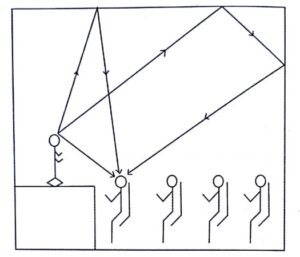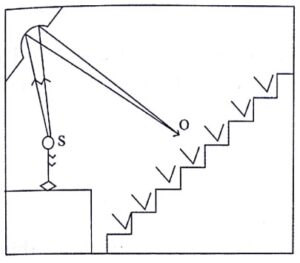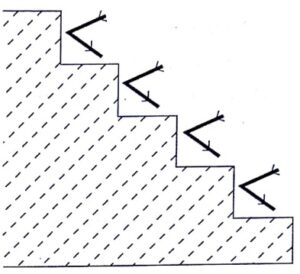The factors affecting the acoustics in a building are as follows.
-
Reverberation and Reverberation time.
-
Loudness.
-
Focussing due to walls and ceilings.
-
Echo.
-
Echelon effect.
-
Resonance.
-
Extraneous noises.
1. Reverberation and reverberation time
- The prolonged reflection of sound from the ceiling, walls, floor, and chairs etc., is called Reverberation.
- It is defined as the persistence of sound even after the sound source is cut-off.
The reverberation time is the time for which the sound stays inside the hall. The reverberation time is defined as the time taken by the sound intensity to fall below minimum audibility i.e, 10-6 times its initial intensity, after the source is cut-off.
- When the reverberation time is too large, the successive sounds overlap and the clarity of sound is lost.
- When the reverberation time is too small the loudness will be inadequate and the sound heard will not be intelligible.
- If the reverberation time is zero, no sound is heard and the hall becomes a dead hall.

Therefore the reverberation time should neither be too large nor too small but it must have a definite optimum value which is satisfactory to both the speaker and the listener. This optimum reverberation time can be found by Sabine’s formula.
Remedies
The reverberation time can be controlled by the following means:
2. Loudness
Remedies
3. Focussing due to walls and ceilings
Remedies
- By avoiding curved surfaces.
- By covering such curved surfaces with suitable absorbing materials.
- By providing low ceilings.
4. Echoes
Remedy
5. Echelon effect
When a hall contains structures of regular repetitions, like stair cases etc., the sound produced by the source may be scattered. This may create nuisance effect due to echoes. “The echoes are formed when the time interval between direct and reflected waves is about 1/15th of a second”. The regular repetition of echoes of the original sound to the observer is called as Echelon effect. This should be avoided.
Remedies


6. Resonance
Sometimes the window panes, sections of the wooden portions and walls lacking in rigidity (loosely fitted) are thrown into vibrations and they create other sounds.
For some note of audio frequency, the frequencies of new sounds may be the same thus resulting in resonance. Such vibrations are called resonant vibrations. Due to this the original sound get distorted. Hence, it can lead to unpleasant effect. These resonant vibrations should be suitably damped.
Remedies
- Avoid loose fittings in the hall.
- Ranging large number of curtains in the hall.
7. Noises
a. Inside noise
Noise produced inside the hall itself or adjacent hall is called as inside noise. These are due to moving people, furnishers working machines etc.
Remedies
To avoid these:
- Machines may be placed over the sound absorbing materials.
- Covering the walls, ceilings with suitable sound absorbing material.
b. Air borne noise
The noises produced outside by the vehicles such as aircrafts, automobiles, trains etc., and carried by air are called as air borne noise.
Remedies
To avoid air borne noise:
- Construct the auditorium well away from the road at a quiet place.
- Construct the compound wall as high as possible little away from the auditorium.
- Construct a double wall enclosure.
- Provide the windows at proper places with curtains.
C. Structure borne noise
Noise which is transmitted through the structure of the building is called structure borne noise.
Eg: Noise due to movement of furniture, machinery operation will produce structural vibrations giving rise to structure borne noise.
Remedies
To avoid the structure borne noise:
- Rubber gaskets can be provided in between the pipelines.
- Double walls fitted with or packed with sand, which is called sand pugging can be constructed.
- A false ceiling can be used.
- By providing carpets.
| Read More Topics |
| Linear flow of heat along a bar |
| De-Broglies concept of matter |
| Experimental verification of compton effect |






